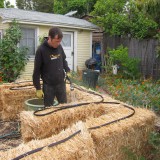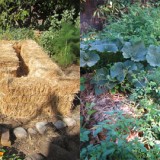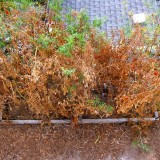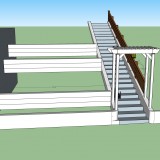 Tidiness is a very pleasant thing inside a house. Outside, in a yard or garden, it’s not at all a good thing. I’m really tired of the cult of tidy.
Tidiness is a very pleasant thing inside a house. Outside, in a yard or garden, it’s not at all a good thing. I’m really tired of the cult of tidy.
We seem to be confused. We conflate our yards with our living rooms, the space beneath our shrubs for kitchen floors. Popular opinion seems to believe our flower and vegetable gardens should be maintained like trophy rooms, like curio cases.
Our mistake, of course, is thinking that everything is about us. That our yard, our garden, our little patch of land actually belongs to us and we have the right to maintain it exactly as we like. We might own it on paper, but we share it with hundreds, thousands, millions (if you want to get into soil biology) of other lives.
Of course, if we maintain our yards to exact standards of tidiness–say our yard consists of a lawn and some shrubs along the drive with the dirt beneath them blown clean, we probably are not supporting much life at all. We’ve put up the No Trespassing sign, and creatures listen.
 It gets even more sparse if we spray herbicides and pesticides all over the place. All of the invisible life vanishes. Any creatures which visit are just passing through.
It gets even more sparse if we spray herbicides and pesticides all over the place. All of the invisible life vanishes. Any creatures which visit are just passing through.
The land is eerily silent.
But life is waiting to come back. That is what is so amazing. It jumps back if given even half a chance. If you open the door just a crack.
All we have to do is sit back and relax.
Stop with the obsessive yard work.
Stop paying the yard crew.
Stop spraying chemicals around.
Just stop.
Leave the leaves. Let fallen leaves and pulled weeds stay on the land to protect and nourish the soil.
Let volunteers bloom.
Let your garden go to seed.
 If we live with fussy neighbors, or under the impression that our gardens should look like the ones in the magazines, we might work hard to keep our vegetable and flower gardens impeccable, starting seedlings in advance to replace aging plants so there’s never any sense of “decline” in the garden.
If we live with fussy neighbors, or under the impression that our gardens should look like the ones in the magazines, we might work hard to keep our vegetable and flower gardens impeccable, starting seedlings in advance to replace aging plants so there’s never any sense of “decline” in the garden.
I’ve always let parts of our garden go to seed, but this year, more than ever, I’m attuned to it. I’m reveling in the beauty in it, and I’m understand the generosity of it down deep, on the soul level.
 In the past I struggled to leave the plants as long as I could stand it, knowing they were doing good in their later life cycle, but also feeling like my yellow, straggly garden made me look lazy or incompetent.
In the past I struggled to leave the plants as long as I could stand it, knowing they were doing good in their later life cycle, but also feeling like my yellow, straggly garden made me look lazy or incompetent.
I was also acutely aware of the long gaps between harvests that would occur if I waited for plants to go to seed before replacing them. Now, I’ve given up all that anxiety, and I revel in this time.
The insects feast on the flowers which bloom on our lettuce, our arugula, our radishes, our mustard, our fennel. Predatory wasps hunt alongside lady bugs and diligent bees of all types.
 We have more birds than ever in our yard, and they love our overgrown, browning beds, because of course they’re eating the seeds or the bugs on the ripening plants. They would not, however, allow me to take any pictures of them doing these things.
We have more birds than ever in our yard, and they love our overgrown, browning beds, because of course they’re eating the seeds or the bugs on the ripening plants. They would not, however, allow me to take any pictures of them doing these things.
They love all the weedy places, the vacant lots and over grown side yards. Those places are full of flashing wings and trilling songs. It’s already a seed time of year here in LA on our fast moving calendar, and I’m watching the birds feast. I love watching the little finches balancing on thin, swaying plant stalks in the golden light of the afternoon. The world is full of moments of perfect, unconscious beauty like that.
Once the seeds are eaten, and the plants are brown and empty, I cut the stalks down at their base, but I don’t throw anything away. Everything stays in the yard, on or in the ground. The plant which fed us and the bee and the finch will now finish its work feeding the soil. Feeding the soil is its deepest work.
And–never worry!– some seed always manages to hit the ground despite all the competition, ensuring volunteers will come up next year, and feed us all again.
One area where I have to admit that I am less than generous is in the matter of radish seed pods. These I don’t leave for the birds, because I like them so much.
Most of you gardeners are probably very familiar with radish seed pods. If you aren’t, they are the fat little pods that show up after a radish plant of any type goes to seed.
They taste like radishes, pretty much, sometimes they’re sweeter, sometimes they’re spicier. Radish pods are both a bonus crop and a fine consolation prize, because even if your radish roots end up puny or woody or otherwise disappointing, you can always eat the pods. They’re best fresh, picked a handful at a time as a snack or to put in a salad, but you can lactoferment or pickle them, too, using pretty much any pickle recipe you prefer.






Oooh, lactofermented radish pods. I have enough daikon pods right now that I bet I could ferment a pint and leave oodles for the garden.
My yard and garden is substantially more alive having let it go quite a bit. I’ve focused on zones that I want to keep a certain way for myself, but still tried to encourage habitat. The rest is going a bit wild and I have birds I’ve never seen, snakes, and an absolutely giant bullfrog in my dilapidated pond.
GREAT post. I was just talking about this while watering the garden with my mom this morning.
A very Thoreau-esque piece.
YES! This is a very timely post – around these parts, my gardens are at an awkward stage between fading spring ephemerals and not-quite-there-yet summer blooms…I admit to feeling a bit worried about how it looks compared to the mow-and-blow neighbors (a side note, I had to move one of those “keep children and animals off the chemically treated grass” signs to my neighbors yard across their driveway – I don’t want anyone getting the wrong idea!). Posts like this are what keep gardeners like us going…I definitely appreciate the confidence boost – thank you! P.S.: I started following your tip awhile ago about leaving pulled weeds as mulch – it drives my parents crazy when they come to visit, but it absolutely works! 😉
This post really resonated with me as we’re surrounded by these obsessively tidy suburbanites who are constantly pulling out the powered yard tools to edge, mow, blow everything into bags for the garbage. I’m doing the exact opposite – letting lots go to flower and seed, some to be eaten by the critters and others for volunteers or to save. And able to use the leaves of the seeding plants for mulch. Eventually to have a food forest instead of lawn and concrete spaces. I’ll also post this to Facebook and try to influence people to change their ways!
This struck a not with me as well. I live in an area that used to be prairie, and remnants can be seen along my road, with native plants of the Silphium genus just beginning to bloom. Goldfinches wait for these seed producers to go into action before having their young, which are fed a strictly vegetarian diet – no insects. Unfortunately the farmers whose fields boarder these roads feel compelled to mow, mow, mow. I asked why this is necessary, and one farmer told me that his landlords (it’s very common to rent as well as own ground in the midwest) insist on the road ditches being mowed. It is so obvious that the natives do not persist on the frequently mowed areas. This includes milkweed, which many of us are planting in vast numbers in a grassroots effort to help the struggling monarch butterfly. A perfectly manicured lawn, especially in the country, means less habitat, for native plants as well as wildlife. So very disappointing.
I struggle with this, as a lazy gardener with a desire to let nature take its course who lives on a corner lot in a suburban HOA. We compromise: the husband takes care of the lawn to HOA standards without the use of chemicals (and uses a human powered push mower, rather than a gas or electric) and I gradually turn the flower beds into edible landscape. In the fall we do leave the leaves as mulch, and in the summer we use grass clippings and thatch. But I sneak enough through the HOA loopholes that I do put some (minimal) effort into keeping everything tidy.
Thanks for this post, Kelly, and Amen!
I’ll have to send you some photos of our very wild back yard, and semi-wild front yard. You can catch a sneak peek in this post from my blog: https://confessionsofalinguaphile.wordpress.com/2016/06/02/composting-joy/
Favourite animal sightings this past week: cedar waxwings, baby toads, big frog tadpoles sprouting legs, chipmunks, red squirrels, and turkey vultures overhead!
Thank you so much for this post. You speak what’s in my heart.
Thank you for the info about the radish seed pods. I never knew! And I appreciate this post as it speaks to my heart that we mess around too much with nature…always trying to clean her up! I see too many people up here in the desert scraping away the weeds and then we have bad dust storms because there is nothing to hold the soil down. And in the fall all the leaves that could protect the soil are bagged up and trashed. Strangely we do not even have green recycling up here (high desert).
Timely post! At the risk of sounding like we actually plan stuff around here, we ended up with both.
We keep the front yard planted with shrubs, small and large, and a handful of perennials surrounded by over-achieving annuals so that keeping it looking nice is never too much work. Most of the annuals are dependable geraniums in a variety of colors which I never buy new, I just root clippings every fall from the old plants and overwinter them inside so they’re ready to go as soon as the weather warms.
The backyard is a different animal. We let the plants go to seed and don’t bother removing the stalks until the birds have cleaned all the seed heads. With this set up we manage to be both neat and orderly plus spiritual and environmental – and terribly smug – all at the same time.
Thanks for the post. Unfortunately, my HOA complains if I let things get “untidy”.
Love this post. I call mine the imperfect garden. Each year is a surprise to see which seeds will grow and where. Leaves are left on the ground as mother nature intended so they can feed the soil.
I love this post. It’s exactly what I do in my garden and it is just ALIVE with creatures. I miss old-timey lawns and yards of my childhood…so much more charming than what’s around today. When did everyone get so fussy?